Melfa (Dogu'a Tembien)
Melfa is a tabia or municipality in the Dogu'a Tembien district of the Tigray Region of Ethiopia and ancient capital of Tembien. The tabia centre is Melfa village itself, located approximately 3 km to the west of the woreda town Hagere Selam.
Melfa | |
|---|---|
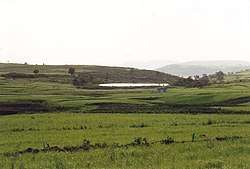 The fertile lands of Melfa with Chini pond | |
 Melfa Location within Ethiopia | |
| Coordinates: 13.640395°N 39.13218°E | |
| Country | Ethiopia |
| Region | Tigray |
| Zone | Debub Misraqawi (Southeastern) |
| Woreda | Dogu'a Tembien |
| Area | |
| • Total | 20.5 km2 (7.9 sq mi) |
| Elevation | 2,500 m (8,200 ft) |
| Time zone | UTC+3 (EAT) |
Geography
The tabia stretches down from the ridge at 2700 m a.s.l. towards Zelekwa/Ruba Dirho River (2150 m a.s.l.).
Geology
From the higher to the lower locations, the following geological formations are present:[1]
Geomorphology and soils
The main geomorphic unit is the Hagere Selam Highlands. Corresponding soil types are:[2]
- Associated soil types
- Inclusions
- Rock outcrops and very shallow soils (Lithic Leptosol)
- Rock outcrops and very shallow soils on limestone (Calcaric Leptosol)
- Deep dark cracking clays with very good natural fertility, waterlogged during the wet season (Chromic Vertisol, Pellic Vertisol)
- Shallow stony dark loams on calcaric material (Calcaric Regosol, Calcaric Cambisol)
- Brown loamy soils on basalt with good natural fertility (Luvisol)
Springs

As there are no permanent rivers, the presence of springs is of utmost importance for the local people. The following are the springs in the tabia:[3]
- May Ayni in Maekhel Gaza
- Shafahambar in May Sa'iri
- May Dera in May Krawa
Reservoirs
In this area with rains that last only for a couple of months per year, reservoirs of different sizes allow harvesting runoff from the rainy season for further use in the dry season. Overall they suffer from siltation.[4] Yet, they strongly contribute to greening the landscape, either through irrigation or seepage water. In Melfa there is:
- Chini (reservoir), constructed in 1993
- Horoyo, household ponds, recently constructed through campaigns[5]
Livelihood
The population lives essentially from crop farming, supplemented with off-season work in nearby towns. The land is dominated by farmlands which are clearly demarcated and are cropped every year. Hence the agricultural system is a permanent upland farming system.[6]
Melfa, and more precisely the May Sa'iri school is one of the first places in Ethiopia where Ecosan toilets were built.
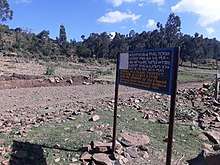
Population
The tabia centre of Melfa holds a few administrative offices and some small shops. The main other populated places in the tabia are:[7]
|
|
Religion and church
Most inhabitants are Orthodox Christians. Most important church in the tabia is Melfa Maryam.
History
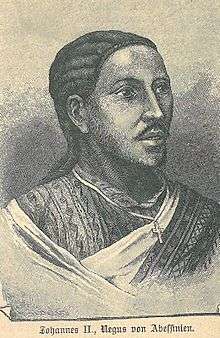
The history of the tabia is strongly confounded with the history of Tembien. As of the 19th Century, both oral traditions and written documents mention that the rulers of Tembien were based in Melfa.[8] Best known is Emperor Yohannes IV, born in Melfa, and whose forefathers had managed to gain power through marriage with all the surrounding ruling families. Kassa (the future emperor Yohannes) controlled the Tembien highlands and later the whole of Tigray; ultimately he crowned himself king of kings of Ethiopia in 1872.[9] However, Emperor Yohannes IV did not establish his capital in Melfa (due to relative inaccessibility), but in Mekelle and Adwa - these towns were well connected to the Red Sea and to inner Ethiopia. Yet, Yohannes kept strong links with Tembien, as indicated by the establishment of a (locally paved) horse-track between Melfa and Mekelle. In 1951, Gebru Gebrehiwot, the new governor, decided to create a new capital of Tembien. First the location of Melfa was chosen. As the inhabitants of Melfa rejected the idea, Hagere Selam was created as a new town.[8] In the 1980s, the area became again a temporary capital in war-faring Ethiopia: the TPLF party established its HQ in a cave in nearby Mahbere Sillasie, whereas the EPDM used a cave in Melfa.
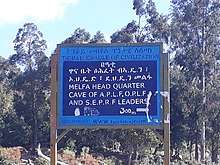
Roads and communication
A rural access road links Melfa to the main asphalt road in Hagere Selam.
Schools
Almost all children of the tabia are schooled,[10] though in some schools there is lack of classrooms, directly related to the large intake in primary schools over the last decades.[11] Schools in the tabia include May Sa'iri school.
Tourism
Its mountainous nature and proximity to Mekelle makes the tabia fit for tourism.[12]
Touristic attractions
- Historic birthplace of Emperor Yohannes
- Headquarters (caves) of the Amhara liberation movement (Ethiopian People's Democratic Movement) during the Ethiopian civil war
Geotouristic sites
The high variability of geological formations and the rugged topography invites for geological and geographic tourism or "geotourism".[13] Geosites in the tabia include:
|
|
Trekking routes
Trekking routes have been established in this tabia.[14] The tracks are not marked on the ground but can be followed using downloaded .GPX files.[15]
- Route 5 follows the upper ridge, north of Melfa
- Route 6 comes from Hagere Selam, and crosses Melfa diagonally towards the lower Ruba Dorho river
- Route 20 follows the Ruba Dorho and Zeleqwa rivers, at the southern side of Melfa
Inda Siwa, the local beer houses
In the main villages, there are traditional beer houses (Inda Siwa), often in unique settings, which are a good place for resting and chatting with the local people. Most renown in the tabia are[3]
- Medhin Kassa at Maekhel Gaza
- Tsedal Girmay at Maekhel Gaza
- Gebregziabher Hagos at Maekhel Gaza
Accommodation and facilities
The facilities are very basic.[16] One may be invited to spend the night in a rural homestead or ask permission to pitch a tent. Hotels are available in Hagere Selam and Mekelle.
More detailed information
For more details on environment, agriculture, rural sociology, hydrology, ecology, culture, etc., see the overall page on the Dogu'a Tembien district.
Gallery
 View on Chini (reservoir)
View on Chini (reservoir)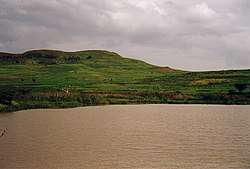 Another view on Chini
Another view on Chini
References
- Sembroni, A.; Molin, P.; Dramis, F. (2019). Regional geology of the Dogu'a Tembien massif. In: Geo-trekking in Ethiopia's Tropical Mountains - The Dogu'a Tembien District. SpringerNature. ISBN 978-3-030-04954-6.
- Nyssen, Jan; Tielens, Sander; Gebreyohannes, Tesfamichael; Araya, Tigist; Teka, Kassa; Van De Wauw, Johan; Degeyndt, Karen; Descheemaeker, Katrien; Amare, Kassa; Haile, Mitiku; Zenebe, Amanuel; Munro, Neil; Walraevens, Kristine; Gebrehiwot, Kindeya; Poesen, Jean; Frankl, Amaury; Tsegay, Alemtsehay; Deckers, Jozef (2019). "Understanding spatial patterns of soils for sustainable agriculture in northern Ethiopia's tropical mountains". PLOS ONE. 14 (10): e0224041. doi:10.1371/journal.pone.0224041. PMC 6804989. PMID 31639144.
- What do we hear from the farmers in Dogu'a Tembien? [in Tigrinya]. Hagere Selam, Ethiopia. 2016. p. 100.
- Nigussie Haregeweyn, and colleagues (2006). "Reservoirs in Tigray: characteristics and sediment deposition problems". Land Degradation and Development. 17: 211–230. doi:10.1002/ldr.698.
- Developers and farmers intertwining interventions: the case of rainwater harvesting and food-for-work in Degua Temben, Tigray, Ethiopia
- Naudts, J (2002). Les Hautes Terres de Tembien, Tigré, Ethiopie; Résistance et limites d'une ancienne civilisation agraire; Conséquences sur la dégradation des terres [MSc dissertation]. CNEARC, Montpellier, France.
- Jacob, M. and colleagues (2019). Geo-trekking map of Dogu'a Tembien (1:50,000). In: Geo-trekking in Ethiopia's Tropical Mountains - The Dogu'a Tembien District. SpringerNature. ISBN 978-3-030-04954-6.
- Smidt, W (2019). "A Short History and Ethnography of the Tembien Tigrayans". Geo-trekking in Ethiopia's Tropical Mountains. GeoGuide. Springer Nature. pp. 63–78. doi:10.1007/978-3-030-04955-3_4. ISBN 978-3-030-04954-6.
- Smidt, W (2010). Tämben from the 18th to 20th century, in: Uhlig S (ed.): Encyclopaedia Aethiopica, Vol 4. Wiesbaden: Harrassowitz. pp. 854–855.
- Socio-demographic profile, food insecurity and food-aid based response. In: Geo-trekking in Ethiopia's Tropical Mountains - The Dogu'a Tembien District. SpringerNature. 2019. ISBN 978-3-030-04954-6.
- Hartjen, C.A. and Priyadarsini, S., 2012. Denial of Education. In The Global Victimization of Children (pp. 271-321). Springer, Boston, MA. https://link.springer.com/chapter/10.1007/978-1-4614-2179-5_8 .
- Geo-trekking in Ethiopia's Tropical Mountains - The Dogu'a Tembien District. SpringerNature. 2019. ISBN 978-3-030-04954-6.
- Miruts Hagos and colleagues (2019). Geosites, Geoheritage, Human-Environment Interactions, and Sustainable Geotourism in Dogu'a Tembien. In: Geo-Trekking in Ethiopia's Tropical Mountains, the Dogu'a Tembien District. SpringerNature. doi:10.1007/978-3-030-04955-3_1. ISBN 978-3-030-04954-6.
- Nyssen, Jan (2019). Description of Trekking Routes in Dogu'a Tembien. GeoGuide. Springer-Nature. pp. 557–675. doi:10.1007/978-3-030-04955-3_38. ISBN 978-3-030-04954-6.
- https://www.openstreetmap.org/traces/tag/nyssen-jacob-frankl
- Nyssen, Jan (2019). "Logistics for the Trekker in a Rural Mountain District of Northern Ethiopia". Geo-trekking in Ethiopia's Tropical Mountains. GeoGuide. Springer-Nature. pp. 537–556. doi:10.1007/978-3-030-04955-3_37. ISBN 978-3-030-04954-6.